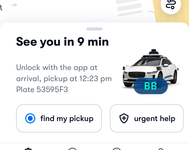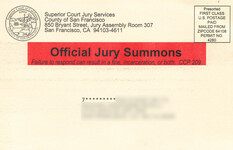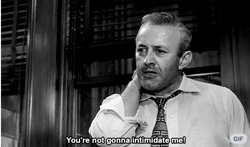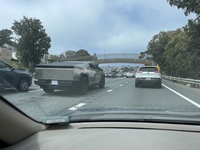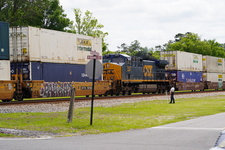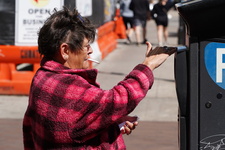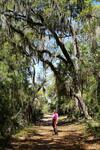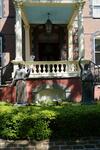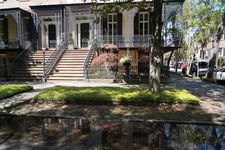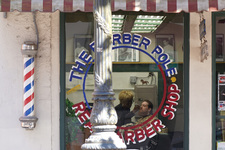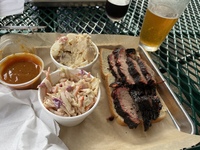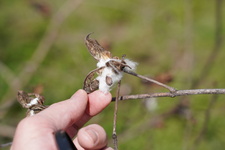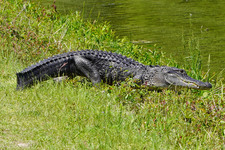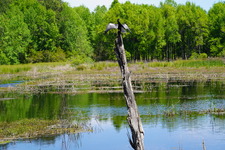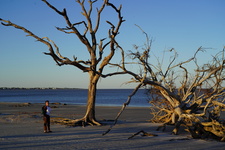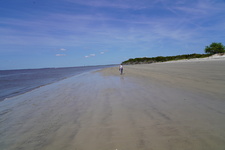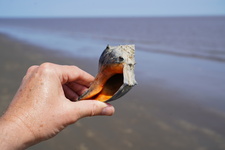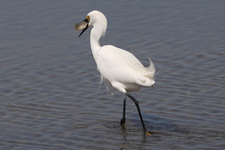 |
| Angelika/Mike Schilli |
Fearlessly Riding In the Robotaxi

|
| Michael reports live from the driverless taxi. |
Michael In Rundbrief 07/2023 I had already reported about our new Waymo robotaxis here in San Francisco, but I had never ordered one before. For those of you at home: Robotaxis are these self-driving vehicles that, like other cars, are zipping through our streets of San Francisco. You can order and use them just like an Uber, except that there's no driver in the front seat. Instead, a Google electronic brain controls the vehicle, presses the pedals, and magically turns the steering wheel.
Now, as you may know, the purpose of this publication is to keep the world on the edge of their seats about current events here in San Francisco. So, I downloaded the 'Waymo One' app, gave it my credit card, and ordered an autonomous taxi on a whim one time when I was too lazy to walk a mile through the city to a targeted pub.
San Francisco residents have gotten used to the white Waymo robotaxis. They're all SUVs of the 'Jaguar F' type with a giant, rapidly rotating radar-like gizmo on the roof, and most people accept them as equal road users who drive exceptionally well. Unlike typical drivers here, they don't make serious mistakes when operating their vehicle, they're not running red lights, and they diligently stop at every stop sign. They're surprisingly quick and alert, don't dawdle because they're playing on their phones, and navigate through traffic faster than so many locals. And, more importantly, they are much more pleasant drivers than our hot-blooded young speedsters who can't drive but love to floor the gas pedal.
That's why I didn't hesitate for a second to order a self-driving car for myself. After about 10 minutes, the vehicle arrived, and a button to unlock the door appeared on the phone app. I pressed it and heard a click at the robotaxi's door. I pulled the handle of the rear side door and opened it. As is customary in America, I got in the back, but you could also sit in the front passenger seat.
I shut the door and plopped down on the back seat. Everything was very quiet, and a faint, eerie space music started playing, similar to what we heard at the visitor center of the Mormon temple we visited long ago. A friendly female voice explained that although everything might feel very futuristic, there'd be nothing to worry about and one should enjoy the ride, but keep my hands off the steering wheel. According to the announcement, the operating company Waymo also runs cameras inside the vehicle but assures that they do not eavesdrop on passengers' conversations or record their operatic singing.
To start the car, I first had to press a start button on the app and then slide a bar across the screen. Then the vehicle set into motion, the car left the parking space, and merged into the flowing traffic very quickly and confidently. It properly stopped at red lights and exemplary yielded to pedestrians when turning. My ride was very short, and the car correctly stopped in a parking bay at the destination. I got out, closed the door, and that was it. Of course, there was no tip for the robot, even though it would have deserved one.
Allegedly, a robotaxi ride in San Francisco is the latest attraction for tourists from all over the world, and who could argue with that? I'll treat our next visitors to a ride. Riding the cable car, walking across the Golden Gate Bridge, and now ordering a robotaxi are all part of the standard itinerary for our trendy visitors, along with our insider tips in Rundbrief 12/2012.
Angelika You know it from various American TV series. In the U.S., twelve jurors decide in court cases whether the defendant is guilty or not. When the court calls, every American citizen must fulfill this jury duty. You've probably guesse it by now: In April, I had the pleasure of being live at one of these selection processes. But let's start from the beginning.
Surprisingly, it is quite unlikely to be selected as a juror because jurors go through a sophisticated and elaborate selection process. In Donald Trump's court case in New York, you might have noticed that it took weeks to select the 12 people. However, one must still report from time to time.
So, in March, a postcard from the "Superior Court" of San Francisco arrived, informing me that I should be ready from April 15 to possibly sit on a jury. Initially, I didn't think much about it because, in rare cases, one has to appear in person at the court. According to the postcard, on the Friday before the week of my jury duty term, I should check the court's website to see if there were any further instructions for my group (a three-digit number). Calling is also an option. Then, the potential juror receives instructions through the court's automated telephone system.
Possible scenarios include: 1) The juror is relieved of duty. Their group is not called. 2) They must check the website or call every day from Monday to Friday to see if they need to appear in person at the court. 3) They must appear in person.
On the mentioned Friday, we were still on vacation. When I casually checked the specified website, I had to rub my eyes at first. My group was clearly listed there, and people with my group number were instructed to appear in person at the court, which is located in San Francisco near the City Hall, on Monday.
I started to get a bit flustered. First, I had to inform my work that I wouldn't be coming in on Monday after the vacation and that I didn't know exactly how many days I would likely be absent, which is always well-received after more than two weeks of vacation.
By the way, the employer must grant you leave for jury duty but is not necessarily required to pay your salary during that time. An employee also cannot be fired for fulfilling their jury duty. The German school where I work pays the normal salary for up to 10 days. If a court case lasts longer than 10 days, you're out of luck. The court pays an allowance of $15 per day starting from the second day, which also includes the days of the selection process. However, our school requires that the $15 be given to the school.
You can surely imagine that this is a real problem for many people if no salary is paid during jury duty. Therefore, there are efforts to increase the allowance to $100 per day for those whose employers do not pay. The jury is supposed to represent the population, and often, people working in low-paying jobs do not receive continued pay.
However, the state does not want to make the role of a juror too lucrative, as it is considered a civic duty and even a privilege of every American citizen. By the way, any citizen can be called to fulfill this duty once a year, although longer intervals are the norm.
In any case, I made my way to the court on the mentioned Monday using public transportation. By the way, everyone automatically gets the fare ($6 per day) reimbursed starting from the second day. I was a bit excited because this isn't something you get to experience every day. I'm a big fan of the American series "Law and Order" and was very curious to see how the whole process unfolds in reality.
When I arrived at the courthouse, a long line had already formed in front of the door, which surprised me a bit. Then the doors opened. Everyone went through a security check, just like at the airport. However, you are allowed to bring everything, including your phone and laptop, into the courthouse. Strangely, I didn't have to show my ID, but only scan my jury duty postcard via barcode. My name and badge number then appeared on the monitor. After that, we were all allowed to gather in a hall-like lobby.
I was astonished at how many people were already seated in the hall. Then it was a matter of waiting. The monitors in the hall displayed information, such as how much compensation each person is entitled to, that potential jurors must reside in San Francisco, be at least 18 years old, and have U.S. citizenship. Two more videos followed. One explained what jury duty is and why it is an important civic duty. The other video was about implicit bias. It emphasized that every defendant should receive a fair trial and be judged solely on the evidence presented.
After the videos, an assistant of the presiding judge appeared and first checked the attendance list. After handling some additional bureaucratic matters, she ceremoniously announced the judge and asked everyone in the hall to stand. The judge was Kathleen A. Kelly, amusingly a niece of our former governor Jerry Brown. She greeted everyone and gave a brief speech about the importance of the juror's role in the American legal system. Then, we all had to stand again and raise our right hand to be sworn in.
Subsequently, the judge announced some details about the upcoming case. She explained that it was a civil trial that would last approximately three weeks (groan). However, she would not be present on Wednesdays due to other commitments. In conclusion, she stated that we all had to appear again tomorrow when the actual jury selection process would begin. Anyone who did not want to apply for a hardship exemption could go home now. Hardship cases are those who can be exempted from jury duty. According to the judge, she carefully reviews these individual cases and grants exemptions only in exceptional circumstances. Being unable to go to work does not count as a hardship. Business trips can potentially be rescheduled. Valid reasons for being exempted from jury duty include medical issues or important exams for students.
The next morning, I appeared at the court again at nine o'clock. Once more, it was a matter of waiting, this time in front of a courtroom door. The court clerk from yesterday appeared precisely at nine o'clock. She had her huge list of names with her again, which she started going through. Everyone had to say "Here" or "Present" when their name was called. Not everyone was present, which did not please the clerk. There were an estimated hundred people standing in front of the door.
Subsequently, she called out the names of 24 out of the 100 people again. These were the potential jurors who were to be questioned first, selected randomly. The clerk instructed each of these 24 individuals to sit in an assigned seat in the jury box. Numbers were hanging above the chairs in the box for this purpose. Since the box only held 12 people, there were additional chairs placed in front of it to accommodate all 24 individuals.
The rest of us were seated in the audience chairs. Once again, we had to stand as the judge entered. After greeting us, she reiterated the important role that each juror plays. She then introduced all the parties: the plaintiff, the defendant, and the attorneys for both sides who were also present in the courtroom. The plaintiff's attorney and the defendant's attorney each gave a brief 3-minute opening statement, outlining the nature of the case.
The plaintiff, with the last name Kukushkin, was an American-Ukrainian investor who had invested 1 million dollars in a cannabis store ("Med Thrive") in San Francisco, along with another Russian investor. The plaintiff demanded that the invested money be repaid, as he claimed it had been embezzled. The judge instructed us that no one in the audience was allowed to use their phone or laptop and that we should attentively follow the questioning of the previously selected jurors. We were to leave the courtroom only during breaks or signal with a hand gesture if we needed to, for example, go to the restroom. Additionally, we were not allowed to research the case online, and googling the names was strictly prohibited.
We were also not allowed to talk about the case among ourselves or post about it on social media. Then the questioning began. In my naivety, I thought that a few questions would be asked of the individual jurors, then some would be dismissed, and the next group would take their place. But that’s not the case. The group of 24 is thoroughly scrutinized. The process takes hours.
First, the judge asked questions, followed by the plaintiff's attorney, and finally the defendant's attorney. The judge initially asked more general questions, such as whether any of the 24 knew the involved parties (plaintiff, defendant, or the attorneys) and were therefore biased. The 24 selected individuals had to state their name, how long they had lived in San Francisco, who lived with them in their household (spouse, children, etc.), what their occupation was or what field they worked in, if they had ever served on a jury before, whether a verdict was reached in that case, and whether it was a civil or criminal case.
The judge explained different types of cases, such as the lower burden of proof required in civil cases, and asked if this would be a problem for those who had previously participated in a criminal trial. The attorneys then asked more specific questions related to the current case, without going into details. They focused on whether potential jurors had ever been business owners, what they thought about contracts and if verbal agreements were valid to them, their views on witnesses with criminal records, their opinions on cannabis stores in general and particularly in their neighborhood, and their attitudes towards Russian investors in the USA.
The plaintiff's attorney had an interesting questioning technique. He confronted the potential jurors with various proverbs and asked them what they thought about them: "Fool me once, shame on you. Fool me twice, shame on me," or "Buyer Beware."
The questioning dragged on for several hours. Then there was a break, and the selection process moved to the next phase. All parties, including the judge and the two attorneys, were allowed to dismiss individuals from the group of 24. The judge typically only dismissed those who approached her personally, such as a potential juror who felt unqualified to sit on the jury due to the complexity of the case and his only moderate English skills. Another person declared herself biased because she was originally from Ukraine.
With the attorneys, it was sometimes easy to understand why they dismissed certain individuals, although they didn't state their reasons publicly. In other cases, it wasn't so clear to me. Eventually, the twelve jurors were selected. But wait, now the alternates needed to be chosen in case someone fell ill. Six more names were called, and those individuals were placed in front of the jury box. This round of questioning went quickly, and three of the six were promptly appointed as alternate jurors.
I was a bit sad that I neither got questioned nor could follow the case further as a juror. However, I was now allowed to google the involved parties. It turned out that the plaintiff, Kukushkin, had previously spent a year in prison for funneling money from Russian investors to U.S. politicians to finance election campaigns, hoping to receive licenses for cannabis stores in return. In the U.S., it is illegal for campaigns to be funded with foreign money. One of his associates, who was also connected to Rudy Giuliani, was also convicted. What a case! By the way, the verdict has since been delivered. Unfortunately, I cannot find out online which party won the case.
Michael Anyone who knows me as an old car enthusiast would, of course, realize it was only a matter of time before I bought Elon Musk's Cybertruck. Really? I sent the photo above to at least 10 friends, each one completely convinced that I had lost my mind and bought the Cybermobile. Okay, I can be expected to do anything, but just so you know: I have never in my life bought a new car from a dealer; I have always bought used ones from private sellers. And for the past few decades, my heart has been with high-revving Honda engines and Japanese designs from the '90s. So, that's how well you know me!
But starting in early May 2024, you could see the first Cybertrucks on the streets of San Francisco, fresh off the assembly line at the Tesla factory. The car is definitely an eye-catcher, you have to admit. The first time I saw one driving next to me on the freeway, it's even possible that I illegally filmed it with my phone!
But no matter how practical it might be to buy one (probably not at all), it illustrates once again why it's a good decision to live here in California and not in Germany: no matter how broken and crazy everything seems right now, we are living in the future and merely anticipating what will one day reach Germany. I prefer to be first.
Michael Attentive newsletter readers already know what a hobo is: As explained in Rundbrief 11/2021, they are drifters who travel illegally across America on freight trains. In that old newsletter issue, I explained why this way of traveling fascinates me, but I put the hobby aside after the accidental death of "Stobe the Hobo." Out of the blue, an American friend recently brought a German book about hobos to my attention, which he couldn't read due to the language barrier.
I quickly bought "König der Hobos" by Fredy Gareis as a Kindle edition on American Amazon, and I must say that rarely has a book captivated me and driven me to keep reading as this one did. Gareis is supposedly a journalist from Germany who spent a few months traveling across the country with hobos in America and recorded his experiences in this book.
During this time, he befriended the hobo celebrity "Shoestring" and accompanied the hardcore vagrant on freight train trips across the vast expanses of America. Shoestring financed these trips by begging at supermarket entrances in small towns during stopovers. Without a doubt, it's a broken world! But the book is incredibly captivating and comes highly recommended for purchase!
Angelika For a long time, I have wanted to travel to the southern states of the USA, specifically Charleston in South Carolina. I'm interested not only in history but also in cities that can tell stories, places with charm and old, architecturally interesting buildings. You don't find much of that on the West Coast of the USA.
The East Coast offers much more in this regard. While preparing for the trip, it quickly became clear that we should visit not only Charleston but also Savannah. Savannah is only 100 miles south of Charleston, but it's already in a different state, Georgia.
Opinions differ on whether Charleston or Savannah is more beautiful. Both offer a lot and have similar attractions; ultimately, it's a matter of taste, but both are worth a visit. Charleston is slightly older and larger than Savannah. It was founded in 1670 and now has a little over 150,000 residents, while Savannah was established in 1733 and currently has 147,780 residents.
Due to my job at the German school, I now have not just one week of Easter break, but two, as is customary in the German school system. This was perfect for our vacation in the southern states. We flew into Charleston, South Carolina, via Charlotte, North Carolina, stayed there for a few days, then continued to Savannah, and finally made our way to the coast to Jekyll Island.
Charleston felt more touristy to us than Savannah. The horse-drawn carriages that took tourists through the historic part of the city were immediately noticeable. The old town boasts beautifully restored buildings and some cobblestone streets. Founded in 1670, Charleston is one of the older American cities. The city's history is reflected in its various architectural styles. It seems like there's a church on every corner, sometimes even two. The proximity to the Atlantic Ocean results in high humidity and a mild (but hot in summer) climate.
Savannah rivals Charleston architecturally. What is particularly charming in Savannah are the numerous squares and parks, reminiscent of Paris, which make the city appear especially green. While Charleston is known for its churches, Savannah is known for its old historic cemeteries, which are lovely to wander through. I particularly liked Bonaventure Cemetery, located just outside the city center. It spans 40 hectares, and many of the graves are over 100 years old.
I met a nice man there who was eager to tell me about the old historic graves. He had an enormous amount of knowledge. When I inquired further, he told me that he was interested in history and cemeteries and often walked his dog through the cemetery to share his knowledge with tourists. As you can see, history is always present in Charleston and Savannah.
Culinary experiences in the southern states tend to be more rustic. Smoked barbecue beef with coleslaw is legendary, tender, and smoky. Michael was also taken with "Shrimp and Grits," shrimp served on a bed of cornmeal porridge. Of course, we enjoyed fresh oysters and fish, and even tried some modern luxury cuisine.
The southern states of the USA are also known for the thriving slave trade conducted there until 1865 and the related American Civil War. The legacy of slavery remains a sensitive topic, with much debate over how it should be addressed, especially in the southern states. Both Charleston and Savannah have several museums and sites that focus on and attempt to address the history of the slave trade. Near Charleston, we visited an old cotton plantation, the McLeod Plantation. There, visitors are presented with the history of the plantation from the perspective of the slaves. Very interesting!
Angelika Mystical landscapes, imbued with a certain nostalgia, have a magical attraction for me. The southern states of the USA have a lot to offer in this regard. In Charleston and especially in Savannah, there are entire avenues of ancient oak trees that spread their branches wide, providing welcome shade. From the branches hangs the abundant Spanish moss, typical for this region, which gives the oaks a unique character. These oak trees are a special variety, called "Live Oak" in English, as they do not lose their leaves in the fall.
My favorite photographer, Sally Mann, has a beautiful photo book titled "Deep South." Sally Mann captures the mood of this historically rich landscape like no other, using old antique cameras for her project. Another book that ignited my desire to explore the southern states of the USA more closely is "Where the Crawdads Sing," in which the protagonist, Kya, lives alone in the swamp and marshland of the southern states (North Carolina). The landscape is formative for the girl, and I loved the passages describing how she glides through the marshland in her boat.
Of course, there's always the risk that the images in your mind don't match reality, but I have to say that I was not disappointed. The Okefenokee Swamp, located in Georgia near the Florida border, exceeded all our expectations. We saw trees rising out of the water, held in place by their unique root systems. Alligators peeked out from the water, and owls watched us warily from the treetops. In the swamp, we discovered vast, football field-sized areas of water lilies as far as the eye could see, along with other water plants we had never seen before. I wouldn't have been at all surprised if a dinosaur had suddenly appeared.
The swamp landscape can only be fully appreciated by exploring it by boat, which we naturally did. You can also rent kayaks and paddle through the swamp yourself, but for our first experience, we opted for a guided boat tour. The boats were small enough that we didn't feel like we were part of a mass tourism event. Our boat guide was a nice young man and a complete outdoor enthusiast. It soon became clear that he had spent his summer vacations in the Okefenokee Swamp as a child, since his grandfather was a ranger there.
His grandfather was completely captivated by the beauty and uniqueness of this landscape and passed on this enthusiasm to his grandson, who then decided as an adult to return from Chicago to the Okefenokee Swamp. The fact that this unique swamp landscape did not fall victim to the madness and greed of the lumber industry, or was even drained, is thanks to the foresight of President Roosevelt, who placed Okefenokee under protection in 1937.
Loyal newsletter readers had recommended Jekyll Island in Georgia to us. So we rented an Airbnb in the small town of Brunswick, not far from Jekyll Island. As I mentioned before, I had certain images in my mind of what the marshlands would look like. When I found a house on Airbnb in Brunswick, a bit outside the city center, that matched these images perfectly, there was no holding back. The house was not only huge but also reasonably priced. The best part was the porch, which was connected to the kitchen and offered an incredible view of the marshland in front of the garden.
We had every meal on the porch and enjoyed the fantastic sunsets. Michael immediately started raving about how he could write a book while sitting on the porch. However, he had to put those plans on hold for the time being, as we wanted to explore the area. The island of Jekyll Island belongs to the state of Georgia. Each time you drive onto the island, which is connected by a bridge, you have to pay a $10 entrance fee. But it is well worth it.
We were especially fascinated by the beaches, where we walked for hours and saw very few people, but found herons, small turtles, and huge shells. Our two favorites were St. Andrews Beach at the southern tip of the island and Driftwood Beach in the northern corner. On Driftwood Beach, hundreds of uprooted trees and logs lie and stand, looking like sculptures and giving the beach a surreal touch that makes any photographer's heart beat faster.
The name of the beach is somewhat misleading, as the trees are not driftwood washed ashore. On the contrary, decades of erosion have uprooted trees that were part of a forest. Since the tide at this beach is not high enough to carry the trees out to sea, they simply remained standing or lying on the beach. Sun, salt, and wind bleached and sanded the trees, giving them a sculptural appearance.
Jekyll Island is, of course, also a vacation island. There are restaurants, hotels, vacation rentals, shops, and an old historic section with spacious old mansions, which are now under monument protection. How did the mansions get on the island? Wealthy and famous American families like J.P. Morgan, Joseph Pulitzer, William K. Vanderbilt, and Marshall Field wanted to use Jekyll Island as a winter retreat and joined the exclusive Jekyll Island Club, which bought the island for this purpose in 1886. The impressive clubhouse is now a hotel. However, due to the economic and geopolitical impacts of World War II, the Jekyll Island Club closed its doors in 1942. In 1947, the state of Georgia bought the island to ensure that everyone can still enjoy Jekyll Island today.
Michael When we were traveling in the southernmost part of California some time ago, we noticed a palm grove off the road, which turned out to be a plantation for harvesting dates. At the next side street, we turned right, and there, standing by the roadside in the blazing sun, was a date vendor whose face had already developed date-like wrinkles from spending so much time in the sun.
As you know, I'm a big fan of dates, so I pulled over to check things out. I got out, approached the folding table where the man had stacked huge red boxes. Wordlessly, he offered me an open box, and I picked out a date with my fingers and ate it. "How much?" I asked, and the man said, "20 dollars!" I fished a twenty out of my pocket, gave it to the man, and received a full box in return. I can tell you, these were the best dates in the Northern Hemisphere. The Medjool date is the queen of dates, and if you can get them fresh, you should grab them immediately. The five pounds were gone in a week. Angelika had already expressed concerns that my mouth or stomach would soon stick together.
The Medjool dates were dark brown, fleshy, and juicy, likely having been harvested shortly before. When you buy dates at the supermarket here, 95% of the time they come out of the package looking light brown and shriveled. And if you check the packing date, it's usually about a month old. Naturally, the shriveling process sets in—so hands off!
By the way, date cultivation on plantations is a science in itself, as I recently learned from a YouTube video about date cultivation. Not only are hundreds of palm trees pollinated by hand and machines, and it can take six or seven years for a palm to bear fruit, but during harvest time, special shakers drive through the rows of the plantation. These machines attach to each palm trunk, and two huge grippers shake the palm so that the ripe dates fall into spread-out nets. A single mature palm tree can yield up to 75 kg of dates per season. After harvest, the dates are transported through huge halls on conveyor belts, where workers sort out the rotten ones, and special robots pack the good ones into plastic boxes that you later see in supermarkets. But, as I said, be careful when buying dates!
Michael Despite all my caution, I've managed to get a splinter more than once while working with wood. For these splinters that get under the skin and are often hard to remove, there seem to be a lot of regionally different terms. For example, in Munich, they say "Schiefer," and in Augsburg, they say "Spelten." In any case, you can try to remove the splinter with tweezers, but that doesn't always work because the piece either doesn't stick out enough or breaks off when you try to pull it out.
The next step is to use a sterilized needle to roughen the callused skin around the entry point, hoping to expose part of the splinter so you can grab its tip with tweezers. But if that doesn't work, what then? From my childhood in Germany, I remembered the so-called "drawing salve," though I recalled it more as a bit of hocus-pocus.
One day, I felt a stubborn little splinter in my fingertip and started looking for solutions. By chance, I found a so-called "drawing salve" named "Prid" on Amazon and ordered it. When I opened the tiny tin, an interesting smell greeted me, a bouquet of liquid tar, sea buckthorn, and maybe caramel?
I applied a glob of the salve to the spot where the splinter had embedded itself, put a bandage on it, and lo and behold, the next morning, the splinter was stuck to the cushion of the bandage. A marvel of medicine! Since then, I've always kept a tin of Prid in my medicine cabinet, and it’s also a must-have on our travel list. Top product!
Michael Do you remember how we explained at length in Rundbrief 11/2022 the effort it took to retain our German citizenship when we acquired U.S. citizenship? Back then, we had to justify it in writing over dozens of pages, submit numerous documents, wait a year for the approval of the so-called Retention Permit (Beibehaltungsgenehmigung, BBG), and then pay 200 dollars to the consulate. As of June 27, 2024, this step will no longer be required.
And this is how it happened: The "Ampel" coalition, the governing coalition in Germany, decided back in 2023 that there was a shortage of skilled workers and that, for this reason, immigrants to Germany should be able to acquire German citizenship through a streamlined process without having to give up their original citizenship. The principle of avoiding dual citizenship, which was anchored in nationality law, was hastily abandoned.
Conversely, this means that Germans who settle abroad can now acquire one or more foreign citizenships without having to give up their German citizenship. The stamp of the BBG official is no longer necessary for this. If I were Detlef Schrempf, who lost his citizenship years ago due to violating this rule, I would call the consulate. We already know dozens of Germans in San Francisco and the surrounding area who are now hastily applying for their U.S. citizenship.
By the way, anyone who thinks a few days won't matter is mistaken and should read the Consulate's information sheet, which states that anyone who acquires U.S. citizenship without a BBG before the deadline on June 27, 2024, will still automatically lose their German citizenship. Order must be maintained!
Greetings from the disorderly city:
Angelika und Michael



